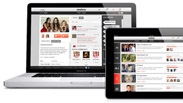BBC iPlayer architect zooms in on social TV

While several European operators are toying with dual screen applications, UK start-up Zeebox has upped the ante by launching an iPad app with the claim this offers a higher level of integration between linear TV services and social networks, especially Twitter and Facebook, than existing products. The iPad App called Zeebox was developed by the eponymous company founded by Anthony Rose, who was the chief technology officer leading development of the BBC’s highly successful iPlayer catch-up service.
Zeebox is a free app that can be downloaded from the Apple iTunes library allowing viewers to exchange recommendations and interact with others via social networks on the basis of what they are watching at the time. It can also display direct links to brands or web sites associated with the program being watched at the time, with the interaction occurring over the Internet via Wi-Fi. The app can also provide access to information relating to the onscreen content via tags that appear on the screen. Rose gave the example of Tom Cruise appearing recently on the BBC program Top Gear, with the actor’s name appearing in a tag linking to his Wikipedia page along with on-demand movies.
Although information can be associated with any program including sports and wildlife, Zeebox is pitched particularly at games, reality shows and soaps, which are sweet spota for the companion screen. Such programs already generate a lot of Facebook and Twitter activity, and products such as Zeebox appeal to broadcasters, pay TV operators and advertisers by giving them the opportunity to harness and exploit this activity. In the UK, programs such as “The X Factor,” “Britain's Got Talent” and “Strictly Come Dancing” generate very large dual-screen activity on Facebook and Twitter, as well as various online forums.
Zeebox is similar in concept to the social TV platform Miso, funded by Google Ventures, which also synchronizes iPads, iPhones and Android devices with the TV. It has been making waves in the US, having been adopted by AT&T for its Uverse IPTV service, and DirecTV for linking iPhones in real time with its satellite TV service. At the moment, these applications are largely confined to finding out what friends are watching and sharing recommendations, but Miso wants to go much further, like Zeebox, and enable deeper engagement as well as providing real time access to information about the current program being watched, along with viewing figures, results of ongoing online voting, and links to related sources of information or content.
In Europe, a few pay TV operators claim to be already moving down this path, notably Orange of France, the world’s eighth largest telecom operator, which has taken a different line with a "check-in" service for TV viewing launched in August 2011. This exploits audio watermarking to inform a viewer’s "companion screen", either a smartphone or a tablet, what program is being shown, then linking back into Facebook. At present, the main application is awarding users points and badges when they check-in, which they can later cash in for various benefits that, in principle, could include a free film or a pay per view access. But Orange believes that this link can also be used to generate advertising revenue.
The watermarking technology in this case, provided by Dutch firm Civolution, inserts an audio mark into content that is unnoticed by the viewer but picked up by the smartphone to trigger in principle any action, depending on the app. This could include opening a web page, playing some associated video or presenting a relevant advert. This is a case of a technology finding an application quite different from its original intention, since Civolution’s audio and visual watermarking was originally developed to combat piracy. It then turned out to be useful for tracking viewing of program or advertising content, and now the audio marks seem tailor made for dual or companion screen applications.
Civolution is not alone in applying audio watermarking to dual screen integration. Yahoo!, in April 2011, purchased IntoNow, vendor of an iPhone app specifically designed to cue actions on the basis of audio watermarks in the content. Yahoo was particularly interested in exploiting the audio watermarks to identify adverts and display associated information on the companion screen, including perhaps click to purchase options. The idea is that people will not want to disturb their viewing on the big screen directly to interact with adverts, but would be happy to do so on the companion screen, depending on the nature of the program being shown.
Get the TV Tech Newsletter
The professional video industry's #1 source for news, trends and product and tech information. Sign up below.
Liberty Global is another major European operator looking to exploit the companion screen. With 17 million customers in Europe, it is the world’s second largest cable operator, and during IBC 2011 announced its Horizon home media gateway to bring connected TVs and second screens into the game. This will be launched by UPC, its Netherlands operation, in Q1 2012, followed in Q2 probably by other countries including UPC Cablecom in Switzerland and Germany’s Unitymedia. This will allow consumers to browse and select content, create favorites and set remote recordings, as well as drag-and-drop content thumbnails to create personal playlists that can then be shared with friends via companion screens. Liberty Global wants to use tablets as second TVs that double as remote controls and EPGs, on the basis that consumers will be happier using those in split screen mode, allowing the main screen to remain uncluttered.
